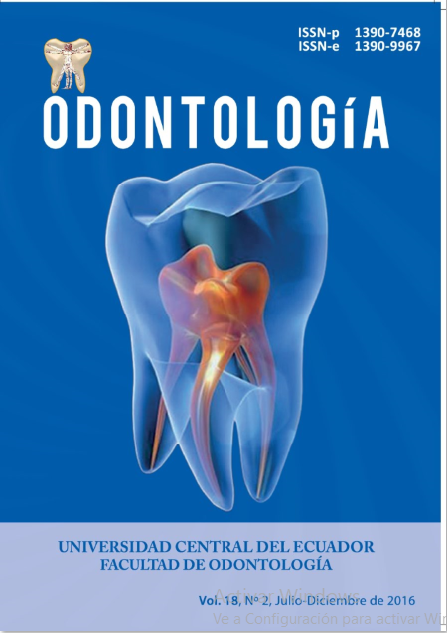Antimicrobial photodynamic therapy as a complement in the direct restorative treatment
Keywords:
Photodynamic therapy, low power laser, dental cariesAbstract
Dental caries is a multifactorial disease that affects a large majority of the population, which presents microorganisms within its development process. However, the main objective in this case report is to reduce the level of microorganisms presents in tissues affected by caries disease, either enamel or dentin to achieve a successful restoration. In this restorative process of dental caries, the use of low-power laser along with a chromophore element, which penetrates the microorganisms, creating a reaction that will destroy the microorganism present in the carious process, this process will be called Photodynamic Therapy (PDT). Antimicrobial Photodynamic Therapy (aPDT) is a technique that combines the activation of a photosensitizer by light in the presence of oxygen producing reactivation of radicals that induced the cell death of the microorganisms. This aPDT has been used to reduce the amount of microorganisms being an antimicrobial potential in the caries process in a direct restorative process, thus avoiding the process of recurrent caries in which it happens when there is no exhaustive previous process of the elimination of the remains of microorganism after clean the cavity with rotating instruments. In the following clinical case report we will present a patient with a caries process in which we introduced the aPDT in the restorative process of tooth 3.5, as an alternative, for an optimal reduction and elimination of microorganisms that involve in the carious process and thus improving the quality of our restoration with resin, and extending the life of this restoration.
Downloads
References
2. Russo E. M. et al., Dentistica Restaurações Dire-tas, Cap. 2, 2010.
3. Dai N, Hu J, Liu H. 3D Simulation Modeling of the Tooth Wear Process. PLoS One. 2015 Aug 4; 10(8):e0134807. doi: 10.1371/journal.pone.0134807.
4. Sharma G, Puranik MP, K R S. Approaches to Ar-resting Dental Caries: An Update. J Clin Diagn Res. 2015 May;9(5):ZE08-11.
5. Zavgorodniy AV, Rohanizadeh R, Swain MV. Ul-trastructure of dentine carious lesions. Arch Oral Biol. 2008 Feb;53(2):124-32.
6. Wainwright M. Photodynamic antimicrobial che-motherapy (PACT). J Antimicrob Chemother. 1998 Jul;42(1):13-28.
7. Williams JA, Pearson GJ, Colles MJ, Wilson M. The photo-activated antibacterial action of tolui-dine blue O in a collagen matrix and in carious dentine. Caries Res. 2004 Nov-Dec;38(6):530-6.
8. Burns T, Wilson M, Pearson GJ. Effect of den-tine and collagen on the lethal photosensiti-zation of Streptococcus mutans. Caries Res. 1995;29(3):192-7.
9. O’Neill JF, Hope CK, Wilson M. Oral bacteria in multi-species biofilms can be killed by red light in the presence of toluidine blue. Lasers Surg Med. 2002;31(2):86-90.
10. Al-Watban FA, Zhang XY. Photodynamic therapy of human undifferentiated thyroid carcinoma-bear-ing nude mice using topical 5-aminolevulinic acid. Photomed Laser Surg. 2005 Apr;23(2):206-11.
11. Dougherty TJ, Gomer CJ, Henderson BW, Jori G, Kessel D, Korbelik M, Moan J, Peng Q. Pho-todynamic therapy. J Natl Cancer Inst. 1998 Jun 17;90(12):889-905.
12. Malik Z, Hanania J, Nitzan Y. Bactericidal effects of photoactivated porphyrins--an alternative ap-proach to antimicrobial drugs. J Photochem Pho-tobiol B. 1990 May;5(3-4):281-93.
13. Convissar RA. Princípios e práticas do laser na odontologia. Pesquisa odontológica com laser. New York; 2011;17: 299.
14. Guglielmi Cde A, Simionato MR, Ramalho KM, Imparato JC, Pinheiro SL, Luz MA. Clinical use of photodynamic antimicrobial chemotherapy for the treatment of deep carious lesions. J Biomed Opt. 2011 Aug;16(8):088003.
15. Zhegova G, Rashkova M, Rocca JP. Minimal-ly invasive treatment of dental caries in primary teeth using an Er:YAG Laser. Laser Ther. 2014 Dec;23(4):249-54.
16. Friedlander L, McElroy K, Daniel B, Cullinan M, Hanlin S. Direct pulp capping of permanent teeth in New Zealand general dental practice--a practice based research study. N Z Dent J. 2015 Jun;111(2):58-64.
17. Diniz IM, Horta ID, Azevedo CS, Elmadjian TR, Matos AB, Simionato MR, Marques MM. Antimi-crobial photodynamic therapy: a promise candi-date for caries lesions treatment. Photodiagnosis Photodyn Ther. 2015 Sep;12(3):511-8.
18. Santin GC, Oliveira DS, Galo R, Borsatto MC, Corona SA. Antimicrobial photodynamic therapy and dental plaque: a systematic review of the litera-ture. Scientific World Journal. 2014;2014:824538.
19. Araújo PV, Correia-Silva Jde F, Gomez RS, Mas-sara Mde L, Cortes ME, Poletto LT. Antimicro-bial effect of photodynamic therapy in carious lesions in vivo, using culture and real-time PCR methods. Photodiagnosis Photodyn Ther. 2015 Sep;12(3):401-7.
20. König K, Teschke M, Sigusch B, Glockmann E, Eick S, Pfister W. Red light kills bacteria via pho-todynamic action. Cell Mol Biol (Noisy-le-grand). 2000 Nov;46(7):1297-303.
21. Steiner-Oliveira C, Longo PL, Aranha AC, Ra-malho KM, Mayer MP, de Paula Eduardo C. Randomized in vivo evaluation of photodynamic antimicrobial chemotherapy on deciduous carious dentin. J Biomed Opt. 2015 Oct;20(10):1080
22 Guglielmi Cde A, Simionato MR, Ramalho KM, Imparato JC, Pinheiro SL, Luz MA. Clinical use of photodynamic antimicrobial chemotherapy for the treatment of deep carious lesions. J Biomed Opt. 2011 Aug;16(8):088003. Borras 2014.
23. Araújo NC, Fontana CR, Bagnato VS, Gerbi ME. Photodynamic Antimicrobial therapy of curcumin in biofilms and carious dentine. Lasers Med Sci. 2014 Mar;29(2):629-35.
24. Wilson M, Dobson J, Harvey W. Sensitization of oral bacteria to killing by low-power laser radia-tion. Curr Microbiol. 1992 Aug;25(2):77-81.
25. Kleina MW, Hermann FCS, Klein-Júnior CA, Piva F. A remoção da dentina cariada na prática restauradora - Revisão da literatura. Rev Dent 2009; 8(18):15-23.


